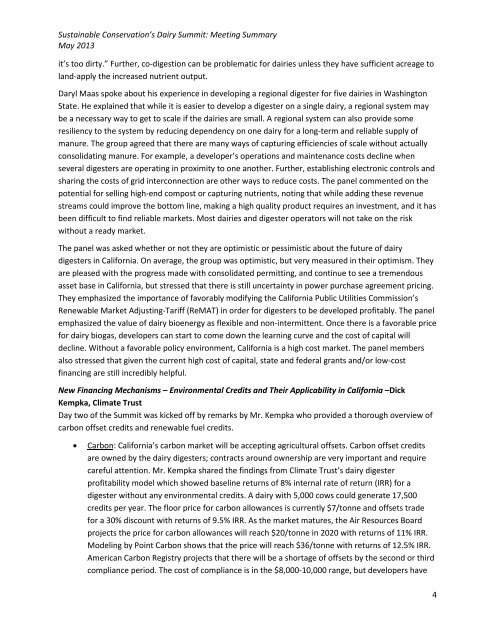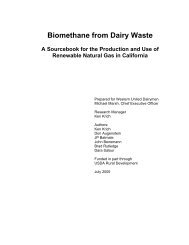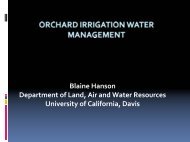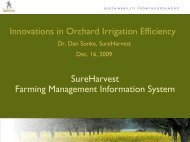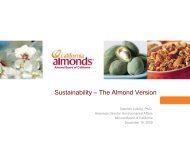Dairy Summit Summary - Sustainable Conservation
Dairy Summit Summary - Sustainable Conservation
Dairy Summit Summary - Sustainable Conservation
Create successful ePaper yourself
Turn your PDF publications into a flip-book with our unique Google optimized e-Paper software.
<strong>Sustainable</strong> <strong>Conservation</strong>’s <strong>Dairy</strong> <strong>Summit</strong>: Meeting <strong>Summary</strong><br />
May 2013<br />
it’s too dirty.” Further, co-digestion can be problematic for dairies unless they have sufficient acreage to<br />
land-apply the increased nutrient output.<br />
Daryl Maas spoke about his experience in developing a regional digester for five dairies in Washington<br />
State. He explained that while it is easier to develop a digester on a single dairy, a regional system may<br />
be a necessary way to get to scale if the dairies are small. A regional system can also provide some<br />
resiliency to the system by reducing dependency on one dairy for a long-term and reliable supply of<br />
manure. The group agreed that there are many ways of capturing efficiencies of scale without actually<br />
consolidating manure. For example, a developer’s operations and maintenance costs decline when<br />
several digesters are operating in proximity to one another. Further, establishing electronic controls and<br />
sharing the costs of grid interconnection are other ways to reduce costs. The panel commented on the<br />
potential for selling high-end compost or capturing nutrients, noting that while adding these revenue<br />
streams could improve the bottom line, making a high quality product requires an investment, and it has<br />
been difficult to find reliable markets. Most dairies and digester operators will not take on the risk<br />
without a ready market.<br />
The panel was asked whether or not they are optimistic or pessimistic about the future of dairy<br />
digesters in California. On average, the group was optimistic, but very measured in their optimism. They<br />
are pleased with the progress made with consolidated permitting, and continue to see a tremendous<br />
asset base in California, but stressed that there is still uncertainty in power purchase agreement pricing.<br />
They emphasized the importance of favorably modifying the California Public Utilities Commission’s<br />
Renewable Market Adjusting-Tariff (ReMAT) in order for digesters to be developed profitably. The panel<br />
emphasized the value of dairy bioenergy as flexible and non-intermittent. Once there is a favorable price<br />
for dairy biogas, developers can start to come down the learning curve and the cost of capital will<br />
decline. Without a favorable policy environment, California is a high cost market. The panel members<br />
also stressed that given the current high cost of capital, state and federal grants and/or low-cost<br />
financing are still incredibly helpful.<br />
New Financing Mechanisms – Environmental Credits and Their Applicability in California –Dick<br />
Kempka, Climate Trust<br />
Day two of the <strong>Summit</strong> was kicked off by remarks by Mr. Kempka who provided a thorough overview of<br />
carbon offset credits and renewable fuel credits.<br />
• Carbon: California’s carbon market will be accepting agricultural offsets. Carbon offset credits<br />
are owned by the dairy digesters; contracts around ownership are very important and require<br />
careful attention. Mr. Kempka shared the findings from Climate Trust’s dairy digester<br />
profitability model which showed baseline returns of 8% internal rate of return (IRR) for a<br />
digester without any environmental credits. A dairy with 5,000 cows could generate 17,500<br />
credits per year. The floor price for carbon allowances is currently $7/tonne and offsets trade<br />
for a 30% discount with returns of 9.5% IRR. As the market matures, the Air Resources Board<br />
projects the price for carbon allowances will reach $20/tonne in 2020 with returns of 11% IRR.<br />
Modeling by Point Carbon shows that the price will reach $36/tonne with returns of 12.5% IRR.<br />
American Carbon Registry projects that there will be a shortage of offsets by the second or third<br />
compliance period. The cost of compliance is in the $8,000-10,000 range, but developers have<br />
4


